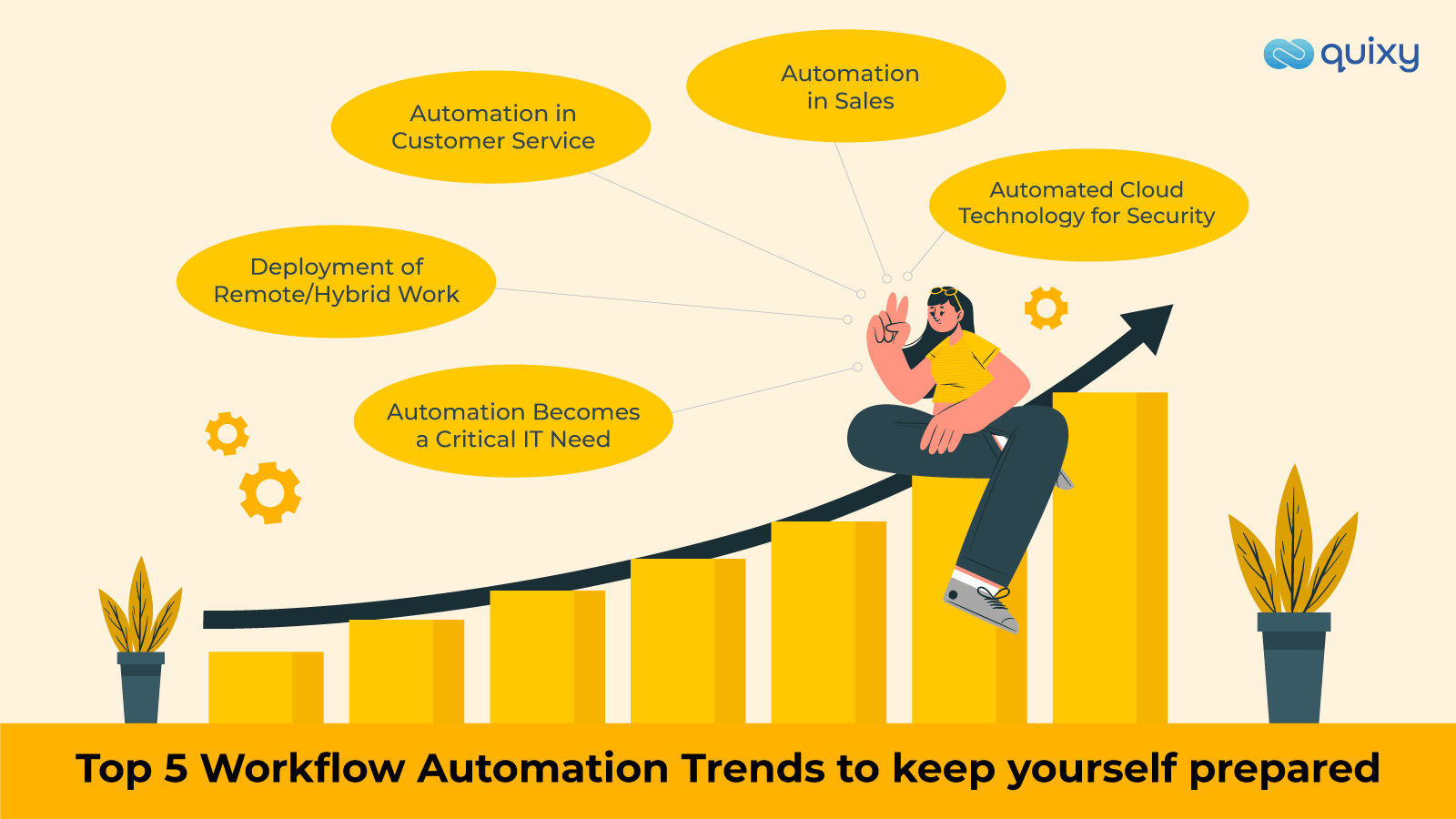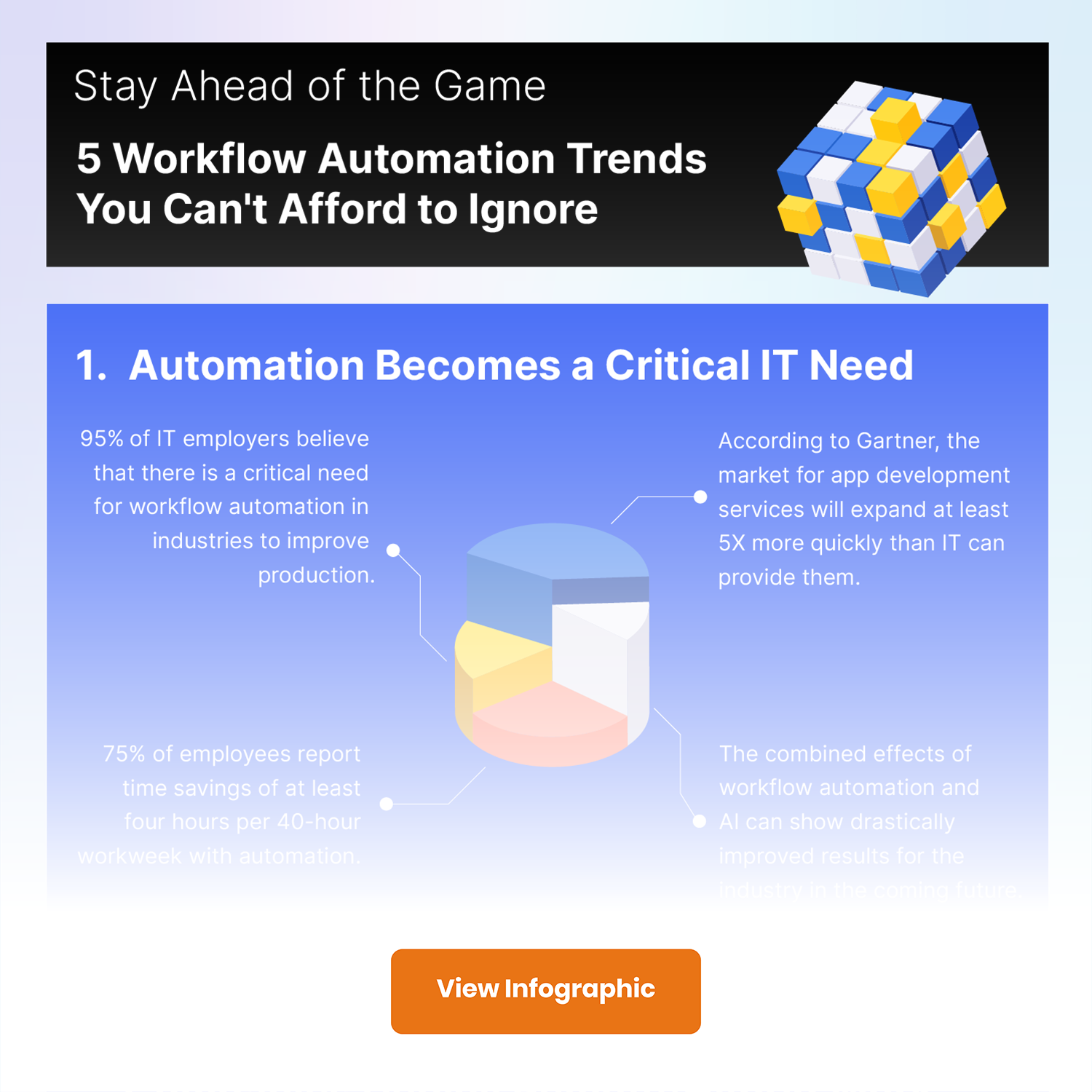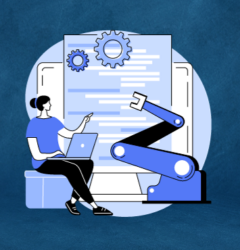
What are the pain points of businesses?
Years back, businesses faced endless issues in their operations like
- Piled documents,
- Inability to find the right information when needed,
- Manually extracting the paper-based documents to update their existing applications,
- Reverting to uncountable customer queries,
- Writing hundreds of emails for marketing and many more tasks done manually.
The endless tasks done by a single individual in a day rigorously affected the time management, productivity and performance of the businesses. This, in turn, lead to stagnant growth. However, let us know what the role of automation is and what are the current workflow automation trends in solving these pain points.
How does workflow automation solve these pain points?
“According to Gartner, by 2026, 30% of enterprises are expected to automate over half of their network operations”
Automated software and solutions are in high demand for various tasks, from sending personalized email campaigns to enhancing customer experience headlines with bots.
Workflow automation, however, is not just used in sales proposals and marketing divisions. It is setting its foot at varied other business operations. And to play smarter, you need to synchronize your business with the latest trends in automation and its impact on the market. Read on to learn the five workflow automation trends to witness how workflow automation solves the pain points of businesses.
The Top 5 Trends in Workflow Automation to keep Yourself Prepared

1. Automation Becomes a Critical IT Need
95% of IT employers believe that there is a critical need for workflow automation in industries to improve production. They also claim that the leaders who are moving with the trends of workflow automation or deploying automation attain good returns on their investments.
Today automation is no more a choice but a need. Manual tasks take much of employees’ time and can lead to unavoidable errors and project delays. In reality, 75% of the employees report time savings of at least four hours per 40-hour workweek. With this, they are getting greater time to build innovation strategies for upcoming projects.
Thinking of Automating? Let’s ponder some questions together and see if your processes are up for automation!
What do stats say?
- “94% of business professionals in enterprise organizations say they would rather build workflow automation on a single platform that integrates their applications than rely on multiple ones.”
Why are such claims made?
“According to Gartner, the market for app development services will expand at least 5X more quickly than IT can provide them.” The strong reason behind such a prediction is that no-code assists software developers in bridging this significant IT gap and empowering business users to create their own solutions.
The combined effects of workflow automation and AI can show drastically improved results for the industry in the future.
Also read: 61+ Workflow Automation Statistics and Forecasts you can’t miss!
2. Workflow Automation Trends Helped Companies Deploy Remote/Hybrid Work
Technical leaders who have deployed workflow automation successfully ratify the existence of remote work. Thus the futuristic approach of remote working is now a trend in workflow automation.
Employees are satisfied with the culture of working remotely, and they say remote work has upgraded their productivity. On the other hand, business leaders report that they can monitor their employees and monitor how they are doing with various jobs and projects.
What do stats say?
The Remote Work and Compensation Pulse Survey says that 48% of employees prefer to work remotely permanently, whereas 44% want a hybrid working model.
Why are such claims made?
Some authentic workflow automation software has made remote work comfortable and productive. Businesses may improve their process by paying vendors, generating content, onboarding new hires, managing contracts, and more.
This trend of workflow automation helps to improve collaboration with their team, effectively using workflow automation software to lower their overall operating expenses, eventually improving their return on investment (ROI).
3. Workflow Automation in Customer Services Increasing Rapidly
Service professionals agree that it is very difficult to satisfy customers. They also report that customers have more difficult queries, making it time-consuming for the professionals to solve. This generates the need for workflow automation trends for customer service professionals to give relief from increasing workloads.
Both the customer and the employee may become impatient with time-consuming manual operations like
What do stats say?
- Most service professionals agree on the fact that currently, such kind of time-taking manual tasks are taken over by automation, making it a current needed trend of workflow automation.
- According to 71% of service decision makers, automation projects are being accelerated, giving rise to the workflow automation market.
Why are such claims made?
A customer service chatbot uses artificial intelligence (AI) and machine learning to respond to common customer inquiries through a business messenger. For instance, queries like “How do I add more users?” also “What are your prices?”
AI chatbots use your existing materials, like FAQs or knowledge base articles, to assist in addressing and resolving customer inquiries. They can be trained to provide prompt responses in your preferred voice and tone, gather background information, respond to questions in various forms, and do follow-ups.
Also Read: Automation Glossary: Master the A to Z of Automation
4. Workflow Automation Trends in Sales
Salespeople struggle to meet the growing demands of customers. Customers reject generic sales pitches and prefer to work with companies that recognize their specific needs and add value. But creating the background necessary to tailor a proposal takes time, and many sales representatives complain that they are too burdened with other duties to obtain the required information.
What do stats say?
- According to 77% of sales representatives, finding the time to gather the necessary consumer insights is a challenge.
- 85% of the customers agree to purchase from a company that comprehends their business goals.
- Felisa Palagi, CEO of Internet Creations, says, “Even though we already possess strong relationships with our clients, AI has helped us develop even closer ones.”
Why are such claims made?
The major pain points of salespeople are excessive time investment in meetings, being bogged down by administrative work, and low lead quality. This trend of workflow automation will drastically grow and will give sales representatives extra time for substantial customer interaction.
Sales manager claims AI to be a basic building block of various workflow automation platforms that helps them to figure out customer requirements, upgrade prediction accuracy and spend more time with customers.

5. Automated Cloud Technology for Security
It’s imperative not to overlook security and compliance if businesses want to digitally transform and modernize their software delivery. With the current trend of remote work, you should seek a way to set up a security-centered organization to mitigate risks while documenting or sharing data. However, file-sharing tools like Google Drive and Dropbox exist, but they cause security lapses.
Enterprises should rather look for a system that provides redactions, documents, and user-based access rights, groups, as well as other data-protection capabilities.
Also Read: AI Workflow Automation: A New Era of Streamlined Processes
What do stats say?
- “According to a recent Gartner study, the first step in tool modernization is automating security and compliance into the business pipeline.”
- You might be surprised to learn that small and medium-sized businesses pay most of the average data breach cost, starting at $3.92 million.
- In fact, small businesses suffer from over 43% of data breaches each year, primarily because of delivery holds for out-of-date software.
Why are such claims made?
The automated ecosystem, integrated modern technologies, and agile software development process influence software and app security. Any business’s scalable operational and technological performance is due to automated cloud technology.
Moving on with the cloud-based workflow automation platforms can save your essential data or information. Spending your money on a cloud-hosted solution that can shield your data against attacks and ransomware is better.
Additionally, it has been stated that businesses are 1.5 times more likely to achieve their organizational objectives when automated security practices are incorporated throughout the development process.

Never Ending Trend of Workflow Automation
With the increase of the workflow automation market, the technologies grow simultaneously, inculcating new features every time. Organizations should make their pace with this trend to beat their competitors.
Enterprises need to focus on strategic thinking to make this trend fruitful. Automation undoubtedly offers extra time to the workforce, but this time should be utilized in innovating and forward-thinking future projects. Quixy, while synchronizing this trend of workflow automation, offers a platform for no-code application development for your enterprise to make it automated and more productive. Begin your journey towards streamlined operations and tailored apps – all with the simplicity of our platform. Get started today to harness the potential of automation.
Frequently Asked Questions(FAQs)
What is the current trend in automation?
Automation is like a high-speed train, and the current trend is all about Artificial Intelligence (AI) and Machine Learning (ML). These technologies are making processes smarter, faster, and more efficient.
What are the process automation trends in 2025?
In 2025, expect to see more focus on hyper-automation, increased use of AI-driven process automation, and a surge in robotic process automation (RPA) adoption. It’s like automation is getting a turbo boost.
What are the workflow automation stats for 2025?
The stats for 2025 show that workflow automation is on the rise. More businesses are embracing it to cut costs, save time, and boost productivity. It’s like a wave of efficiency sweeping through industries.
What are the trends in business automation?
Business automation is evolving to be more user-friendly and versatile. Low-code and no-code solutions are gaining popularity, making automation accessible to a broader audience. It’s like automation is becoming everyone’s tool.
What is the next big thing in automation?
The next big thing is probably the Internet of Things (IoT) combined with automation. It’s like everything, from your fridge to your car, will start working together to make life more convenient.
What is the future of automation?
The future of automation is exciting. Think self-driving cars, smart homes, and even more AI in our daily lives. It’s like we’re on the cusp of a new era where automation makes things easier and smarter than ever.
Subscribe
Login
Please login to comment
0 Comments
Oldest















